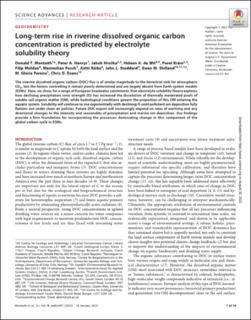Long-term rise in riverine dissolved organic carbon concentration is predicted by electrolyte solubility theory
Monteith, Donald T.; Henrys, Peter A.; Hruška, Jakub; de Wit, Heleen; Krám, Pavel; Moldan, Filip; Posch, Maximilian; Räike, Antti; Stoddard, John L.; Shilland, Ewan M.; Pereira, M. Gloria; Evans, Chris D.
Peer reviewed, Journal article
Published version
Permanent lenke
https://hdl.handle.net/11250/3118885Utgivelsesdato
2023Metadata
Vis full innførselSamlinger
- Publikasjoner fra Cristin - NIVA [2160]
- Scientific publications [1172]
Sammendrag
The riverine dissolved organic carbon (DOC) flux is of similar magnitude to the terrestrial sink for atmospheric CO2, but the factors controlling it remain poorly determined and are largely absent from Earth system models (ESMs). Here, we show, for a range of European headwater catchments, that electrolyte solubility theory explains how declining precipitation ionic strength (IS) has increased the dissolution of thermally moderated pools of soluble soil organic matter (OM), while hydrological conditions govern the proportion of this OM entering the aquatic system. Solubility will continue to rise exponentially with declining IS until pollutant ion deposition fully flattens out under clean air policies. Future DOC export will increasingly depend on rates of warming and any directional changes to the intensity and seasonality of precipitation and marine ion deposition. Our findings provide a firm foundation for incorporating the processes dominating change in this component of the global carbon cycle in ESMs.

